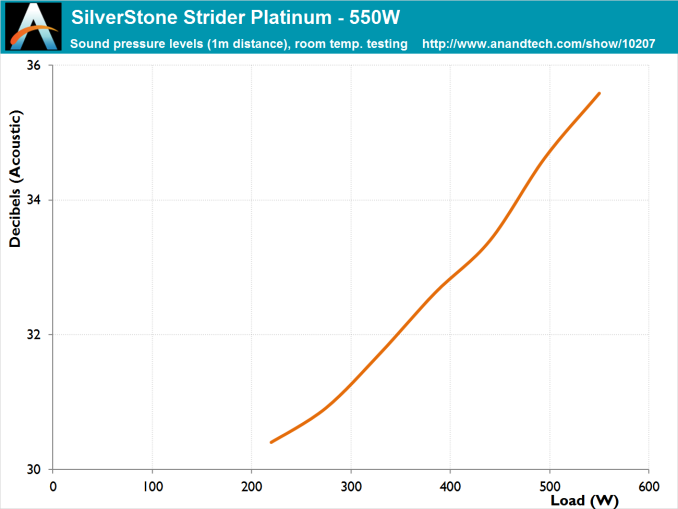The SilverStone Strider Platinum 550W PSU Review
by E. Fylladitakis on April 8, 2016 8:00 AM EST- Posted in
- PSUs
- Cases/Cooling/PSUs
- 550W
- SilverStone
- 80Plus Platinum
Cold Test Results
For the testing of PSUs, we are using high precision electronic loads with a maximum power draw of 2700 Watts, a Rigol DS5042M 40 MHz oscilloscope, an Extech 380803 power analyzer, two high precision UNI-T UT-325 digital thermometers, an Extech HD600 SPL meter, a self-designed hotbox and various other bits and parts. For a thorough explanation of our testing methodology and more details on our equipment, please refer to our How We Test PSUs - 2014 Pipeline post.
The conversion efficiency of the Strider Platinum 550W at room temperature is good, although it technically missed the 80Plus Platinum certification limits during our testing. For 80Plus Platinum units under 230VAC input, the directive dictates that the unit should have an efficiency of at least 92% under 20% load and our instrumentation ended up recording 91.6% at that point. The actual difference is small and can be even attributed to the slightly higher ambient temperature of our testing environment (room temperature is defined as 25 °C and that is used for 80Plus certification tests, while our room temperature was nearly 27 °C at the time of our testing). The average efficiency is 92.4% within the nominal load range (20% to 100% of the unit's capacity) and reaches up to 94.1% at 50% load, just above the 80Plus Platinum certification mark. It is also worthwhile to mention that the Strider Platinum displayed some of the best low load efficiency figures that we have seen to this date.
As this is a semi-fanless (zero fan speed idle) design, the fan is programmed not to start until it is necessary for the cooling needs of the unit. During our testing in room temperature, the fan started right before the load reached 220 Watts, 40% of the unit’s maximum capacity. After that point, the fan started and continued to increase its speed alongside with the load, but barely reached up to 60% of its maximum speed at full load, generating just above 36 dB(A). Due to the relatively high efficiency of the PSU, the Strider Platinum held low operating temperatures during our room temperature testing, barely reaching above 55 °C.















27 Comments
View All Comments
ImSpartacus - Friday, April 8, 2016 - link
Always awesome to see a psu review for a psu that I might actually consider.I also like the commentary about the rarity of low wattage platinum power supplies. I hasn't thought about it from that perspective.
close - Friday, April 8, 2016 - link
I guess people with "low power" systems rarely want to invest the extra money in better efficiency at that price level. This bring diminishing returns the smaller the PSU wattage is meaning you pay the same "extra" for the efficiency but get smaller benefits than you would on a 700+W PSU.close - Friday, April 8, 2016 - link
*on the first line it should read "at that power level", not price.ImSpartacus - Friday, April 8, 2016 - link
Yeah, I can definitely understand why that's the case. It's a reasonable perspective.Though, I don't know if I'd consider a 500W pc to be "low wattage." That's realistically all most single gpu gaming rigs ever need.
Murloc - Saturday, April 9, 2016 - link
low wattage as in the difference in efficiency is negligible from a power bill point of view, or actually a minus if you consider higher cost.Daniel Egger - Saturday, April 9, 2016 - link
Where I live you're typically pay 2€ per year per Watt consumed 27/4 (tendency rising). That can add up very quickly; my first home server used a total of 115W sustained, the successor was down to 65W, the next successor was down to 54W initially and then further tweaked down to 40W. That's a hell lot of money saved per year...close - Monday, April 11, 2016 - link
That's exactly what I meant by low wattage. When you have a sub-500W system the savings in economy are rarely recovered via increased efficiency. You need a higher difference from efficiency and to run the system 24/7 to get real benefits. Otherwise you just move the costs from really small installments every month for a few years into a bigger chunk payed at the purchase of the PSU.Namisecond - Monday, April 11, 2016 - link
Actually, you need to look at the efficiency curve. Most power supplies hit their highest efficiency at between 40-75% utilization. Unless you've got a monster gaming rig with dual or more SLI/Crossfire GPUs, you're not going to be in that zone with a 1200-1500W PSU.A single moderate (GTX970/980) GPU system with a quad core processor will probably hit about 300-350W while gaming. About where you want to be with a 500-600W PSU.
random2 - Wednesday, April 20, 2016 - link
Wattage aint everything. Many cheaper PSUs don't have the amps on the 12 volt rail necessary to push major GPUs.random2 - Wednesday, April 20, 2016 - link
Not to mention the 46 amps on the 12v rail. :)